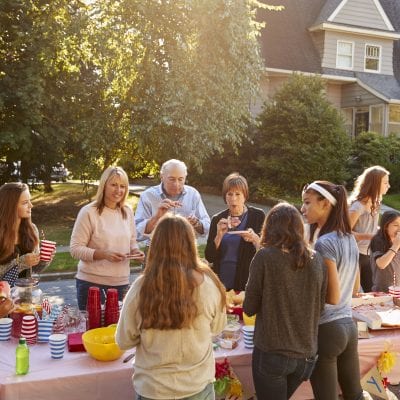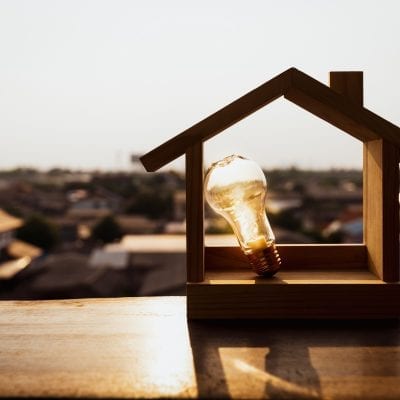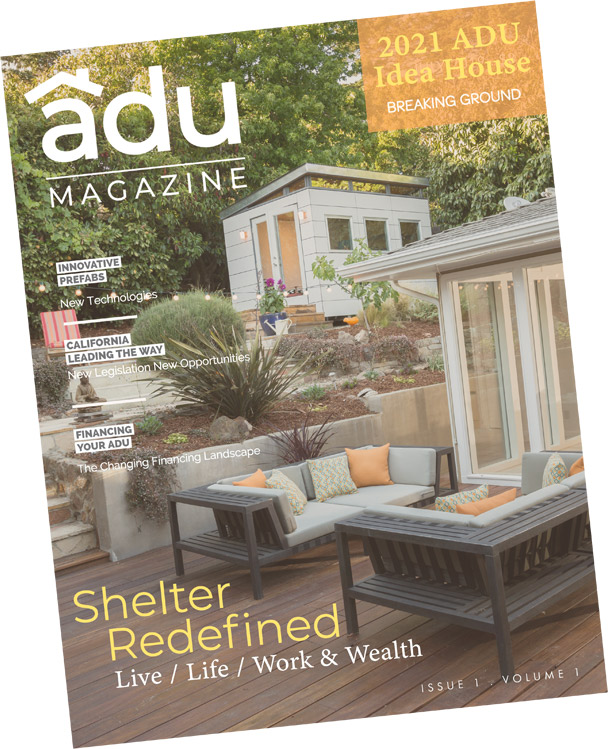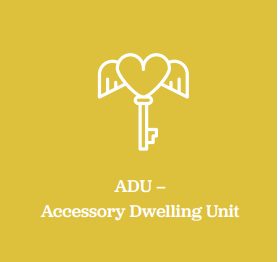
ACCESSORY DWELLING Unit (ADU)
The 2021 ADU Idea House is setting the standard as the Ultimate Live / Life / Work & Wealth Dwelling.
But, do you know what an ADU is?
It’s the acronym that’s sweeping the home building and real estate industry.
ADU stands for Accessory Dwelling Unit.
Odds are you have probably seen one or heard of one – you just likely didn’t know their official name. ADU’s are often referred to as Granny Flats, Carriage Houses, Laneway Houses (on an alley), and Mother in Law Suite/Quarters. The names abound, but they generally refer to an additional living area.
ADU – WHAT’S IN A NAME? LEARN MORE ABOUT THE MYRIAD OF ADU NAMES

Accessory Dwelling Unit (ADU)
An Accessory Dwelling Unit (ADU) is generally a smaller unit located on your property in addition to your main home. The ADU can be used as a rental, housing for aging family, children, or relatives, as a home office, or even more formal play structure. The options are limitless, and more and more ways to utilize them are developed with each passing day.
Typically, an ADU is not attached to your main home unless it is smaller, making it different than a more traditional home addition where you might build on to your existing structure. But the types vary.
A more traditional detached ADU would technically be called a DADU – Detached Accessory Dwelling Unit. Another type of attached unit (usually smaller than 500 sq. ft.), which might be a bedroom in a home or basement that has been transformed into a living space, would be a JADU – Junior Accessory Dwelling Unit. They even have RADU’s – Rural Accessory Dwelling Units, which would more traditionally be on a larger property, farm, or ranch.
You get the idea!
THE TYPES OF ADUs – LEARN MORE ABOUT THE DIFFERENT TYPES OF ADUs
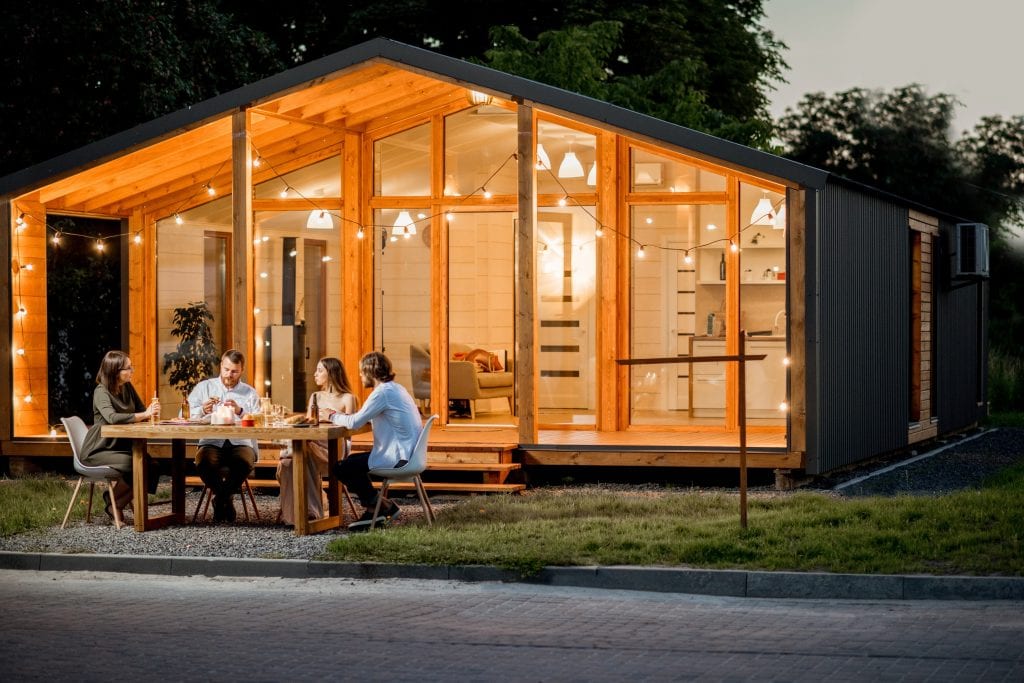
An ADU added to your property can be a great way to make rental income, increase the value of your home, and create a dedicated space for family to move in, become your home office, or even function as a room for a nanny or caretaker. They can also possibly be a residence to prepare for Aging-in-Place for an eventual move if your current home is too costly to renovate.
WHY BUILD AN ADU? – LEARN MORE ABOUT WHY YOU MIGHT BUILD AN ADU ON YOUR PROPERTY
California has been experiencing an extended and increasing housing shortage. The state has the 49th lowest ratio of housing units per resident, and home affordability has been an ongoing issue for buyers in many geographic areas. In response to this, former Governor Brown announced changes to ADU law statewide in 2018, allowing homeowners the ability to create an ADU up to 1200 square feet (though the actual square footage is often regulated and mandated by local law, and there are limitations on amount of lot coverage to property). He had earlier signed legislation to reduce the cost and bureaucracy needed to construct an ADU.
CALIFORNIA: LEADING THE WAY – LEARN HOW CALIFORNIA’S LEGISLATURE HAS LEGITIMITIZED – POPULARIZED – ADUs
The incoming administration with Governor Newsom hoped to outline more details about ADU’s and focused on creating additional housing as a top priority within the state. Including signing legislation and making statewide changes in ADU law as part of a push for infill housing. This expanded the opportunity for many homeowners to develop ADU’s on their property. Giving individuals the chance to help with the ongoing housing crisis, take advantage of their property to maximize its value, make it more functional, and potentially generate extra income.
Doing well, by doing good!
LEARN MORE ABOUT ADU LEGISLATION – DISCOVER THE KEY LEGISLATION SUPPORTING ADUs

But thinking about an ADU comes with many questions. Information needs to be gathered, and thoughtful planning taken, when creating new housing that adds to cities and neighborhoods without taking away from the quality of life. When you think outside of the box, though, moving from the perspective of traditional housing, there are numerous opportunities to create custom spaces on your property and ideas about what that could look like.
Our take on the perfect ADU is one that complements the main house (primary home). The two homes (the primary home and new ADU) in our minds must support each other and function together to create the perfect space both inside and out.
While they can function as standalone dwellings, ideally, they are supportive companions of each other. They both have an obligation to one another to enhance the overall property and to create spaces that improve the community and do their part to address the many challenges our state and country need to acknowledge as we build housing in this century. Those challenges include considerations about sustainability, energy efficiency, carbon neutrality, Aging in Place, and generational living. They should also strive to be technologically advanced dwellings. This additionally includes creating work opportunities and aspects of working from home that could potentially offset living costs and ease each of our burdens on transportation and infrastructure.
During the Great Recession, we noticed distinct changes in the economy and how people look at their finances and living situations. The Gig Economy helped many millennials and other generations survive during hard economic times. We also saw an increase in desire for experiences and a greater appreciation for living small and sustainably. Partly out of financial necessity, and partly out of an understanding of how our individual footprints and lives are interconnected and impact one another. Many of these have resulted in creating trends that while originally developed during the Great Recession, continued during better economic times, and now are at top of mind again in the age of COVID-19. This specifically and notably relates to housing.
Economic issues and considerations about how we live with and relate to one another have carried over and impacted how many of us are approaching our living and dwelling spaces. Opinions, market, and economic factors have specifically created an openness and acceptance of multigenerational and flexible housing. For example, apartment or multifamily living with “pods,” bedrooms coupled with other shared dwelling areas such as kitchens and living rooms that replace traditional one-bedroom apartments and studios, are gaining acceptance. This is especially notable with Millennials who wish collaborative social interaction with one another and who may have limited resources as well as those Baby Boomers seeking to maximize their monetary resources in later age or considering Aging in Place issues. Multigenerational and flexible housing relationships are growing, and both Millennials and Baby Boomers are open to new types of associations. Ironically, in many cases, both generations are also, to an extent, looking for the same types of homes, features, and living spaces.
Today’s homebuyers and homeowners are savvier than ever before. They want to do more in and with their homes. It’s no coincidence that they have coined the phrase – House Hacking.
And we have spared no expense and effort in our quest to create a singularly unique home that demonstrates and highlights all the potential opportunities ADUs present.


